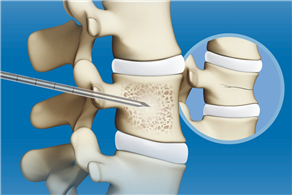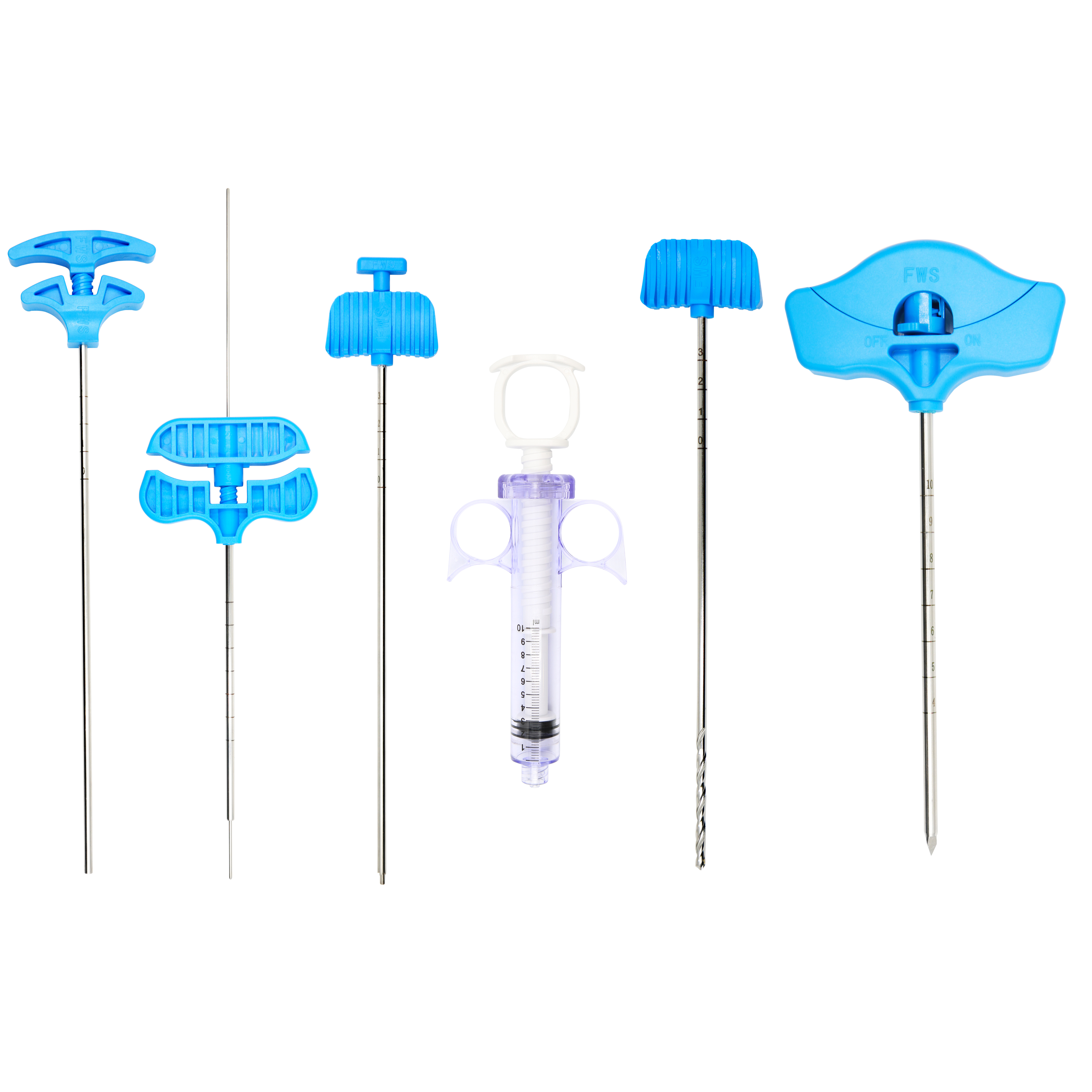Instructions
Surgical procedure
Surgical methods:
Possible surgical methods include transpedicle and posterolateral transforaminal, the specific operation is selected by the clinician according to the actual situation.
instruct:
1. Under the C-arm machine, choose a suitable surgical approach, and puncture the collapsed vertebral body with a locking puncture needle or a rotating puncture needle;
2. Take out the puncture needle core and leave the cannula inside the needle; if a biopsy is required, use a hollow vertebral drill to take the sample;
3. Mix the bone cement and use a bone cement syringe to inject the bone cement into the compressed vertebral body under X-ray monitoring. The injection volume of bone cement is generally controlled at 3~6ml;
4. If performing balloon dilatation kyphoplasty, remove the needle core after the puncture is completed, take out the guide needle from the puncture needle sleeve, and take out the puncture needle sleeve;
5. Under the guidance of the guide needle, insert the expansion tube, which can be rotated to reduce resistance;
6. Take out the guide needle and the expansion tube, leaving the working sleeve as a working channel;
7. The solid vertebral body drill enters the bone passage through the working sleeve to remove bone, and the drill bit can be repeatedly moved in and out to remove bone debris; if a biopsy is required, a hollow vertebral body drill is used to take the sample.
8. Prepare the bone cement and inject it into the sleeve of the bone cement syringe when it is gruel. When the bone cement is toothpaste-like, place the bone cement syringe which is containing the bone cement in the expansion tube sleeve and the bone working channel, and use the bone cement syringe to inject the bone cement into the vertebral cavity under X-ray monitoring. The amount of bone cement is generally 0.5-1 ml more than that of the expansion balloon contrast agent. Perform the opposite operation in the same way. After completion, pull out the manipulator and bandage partly, and the operation is completed.
Features
- Minimally invasive surgery method, less damage to human tissues and less bleeding;
- The operation is simple and convenient, and the operation time is short (about 25-30 minutes);
- Local anesthesia can be used, the risk of surgery is small, and the probability of complications is low;
- Immediately strengthen the injured vertebrae and improve the patient's mobility;
- The pain of the patient was relieved immediately after the operation, and the effect was obvious;
- It can reset the compressed fracture of the vertebral body and correct the kyphotic deformity.
Specifications
| Model |
Component |
Specification |
| FWS-007A |
Ⅰ |
Puncture needle with lock |
Φ2.5×100, Φ2.5×130, Φ3.2×100, Φ3.2×130
|
| Bone cement injector |
Φ20.0×105 |
| Ⅱ |
Rotating puncture needle |
Φ2.5×100, Φ2.5×130, Φ3.2×100, Φ3.2×130 |
| Bone cement injector |
Φ20.0×105 |
| FWS-007B |
Ⅰ |
Puncture needle with lock |
Φ3.0×100, Φ3.5×126, Φ3.0×130, Φ4.0×126 |
| Solid vertebral drill |
Φ3.0×190, Φ3.4×190, Φ3.6×190 |
| Hollow vertebral drill |
Φ3.0×190, Φ3.4×190 |
| Putter |
Φ2.0×220 |
| Bone cement injector |
Φ20.0×105 |
| Ⅱ |
Rotating puncture needle |
Φ3.0×100, Φ3.5×126, Φ3.0×130, Φ4.0×126 |
| Solid vertebral drill |
Φ3.0×190, Φ3.4×190, Φ3.6×190 |
| Hollow vertebral drill |
Φ3.0×190, Φ3.4×190 |
| Putter |
Φ2.0×220 |
| Bone cement injector |
Φ20.0×105 |
| FWS-007C |
Ⅰ |
Puncture needle with lock |
Φ3.0×100, Φ3.5×126, Φ3.0×130, Φ4.0×126 |
| Guide needle |
Φ1.2×300, Φ1.5×300 |
| Expansion orthosis |
Φ3.4×190 |
| Expansion tube |
Φ3.4×125, Φ3.6×125 |
| Working casing |
Φ4.0×120, Φ4.2×120 |
| Solid vertebral drill |
Φ3.0×190, Φ3.4×190, Φ3.6×190 |
| Hollow vertebral drill |
Φ3.0×190, Φ3.4×190 |
| Putter |
Φ2.0×220 |
| Bone cement injector |
Φ3.0×195, Φ3.4×195 |
| Ⅱ |
Rotating puncture needle |
Φ3.0×100, Φ3.5×126, Φ3.0×130, Φ4.0×126 |
| Guide needle |
Φ1.2×300, Φ1.5×300 |
| Expansion orthosis |
Φ3.4×190 |
| Expansion tube |
Φ3.4×125, Φ3.6×125 |
| Working casing |
Φ4.0×120, Φ4.2×120 |
| Solid vertebral drill |
Φ3.0×190, Φ3.4×190, Φ3.6×190 |
| Hollow vertebral drill |
Φ3.0×190, Φ3.4×190 |
| Putter |
Φ2.0×220 |
| Bone cement injector |
Φ3.0×195, Φ3.4×195 |
Scope of application
Used for percutaneous kyphoplasty (PVP&PKP) minimally invasive surgery to form a channel, restore the height of the vertebral body, and form a bone cement perfusion cavity. It is suitable for vertebral compression fractures caused by middle-aged and elderly osteoporosis, the posterior edge of the vertebral body is intact and there is no nerve damage



